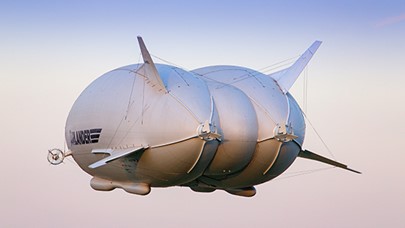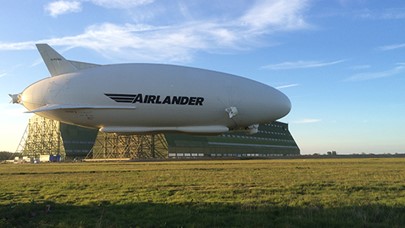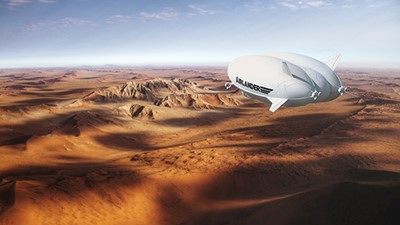Airlander will be Type Certified and capable of flying in a wide range of weather conditions, just like any other commercial aircraft. This includes high and low temperatures, icing, wind, rain, snow, and lightning environments.
The industry standard
All Type Certified commercial aircraft must operate to strict standards and Airlander will be no different.
To certify our production Airlander 10 for the wide range of weather required, HAV uses the same safety standards as other aircraft. These safety standards are used to specify the aircraft requirements and include the testing of equipment and structural samples. The final step is the flight test programme. Airlander will complete a flight test programme of more than 1,000 flying hours. The programme will expose Airlander to the weather conditions that it will see in service, including dedicated hot and cold weather trials.
Our Head of Systems Engineering, Electrical and Avionics explains the different weather conditions that must be considered when Type Certifying a new aircraft like Airlander.

Wind
Airlander 10 will be capable of safely taking off and landing in up to 30 knots of wind. This is similar to the crosswind limits of commercial fixed wing aircraft – the Boeing 737 has a maximum crosswind limit of 35 knots.
Airlander will have an extra benefit that other large aircraft do not have. Airlander is not crosswind restricted as it can simply turn into the wind and take off in any direction.
Airlander has a top speed of around 70 knots. While in flight, Airlander is much less affected by headwinds than earlier airship designs. Airlander 10’s enhanced aerodynamic shape and greater thrust to drag ratio allows it to operate at higher speeds.
Rain
Airlander and its external electronics will be fully waterproofed, allowing Airlander to operate in rain and from water.
Snow
In flight, snow isn’t an issue for Airlander as its speed ensures the snow cannot settle. For Airlander, this is the case at any speed greater than 25 knots.
While stationary on the ground, snow must be periodically removed to stop it building up on the hull and tailfins. This will be carried out by ground crew, in the same way snow is removed from other large aircraft.

Lightning
Like all other Type Certified commercial aircraft, Airlander 10 must be capable of withstanding lightning strikes. This is a basic regulatory requirement.
A traditional passenger aeroplane has a lightning protection system that controls the lightning strike, stopping it from entering the aircraft. Airlander’s lightning protection will work in the same way.
The hull is protected by conductive braids on the outside of the hull. These are positioned so that a lightning strike attaches to the lightning protection conductors and is then dissipated in a controlled manner. The payload module protection is a very thin conductive mesh built into the outer skin of the module, which conducts the lightning strike across the skin rather than inside the payload module.
Certification of the lightning protection features on Airlander 10 will be through an aerospace industry standard process. This will include laboratory lightning strike tests to demonstrate that the protection system works.
Temperature
Airlander 10 will be capable of operating between -40 (the minimum standard temperature in the Artic at 12,000 feet) and +55 (typical maximum summer temperatures). These are comparable with operating temperatures for most large commercial aircraft.
Icing
Every Type Certified commercial aircraft must be able to mitigate the effects of icing. Airlander was designed to operate in a wide range of temperatures to allow worldwide operation. This includes conditions where icing might occur.
Any areas of the aircraft where ice could build up in flight will have ice protection. All these elements will be fully tested as part of Type Certification. Preventing icing on aircraft is well understood and Airlander will have design features for ice clearance including:
- Ice detection and outside air temperature sensors
- Ice protection of vital fuel system components
- Ice protection of engine air intakes and oil breathers
- Electrically heated propeller blades
- Electrically heated instrument pitot heads and static plates
- Heated flight deck windscreens
- Electrically heated helium and air valves
Sunshine
Airlander’s hull is filled with helium. The amount of static lift the helium provides is greatly affected by its temperature. The colder the helium is the lower the lift, the hotter the helium, the more lift the aircraft has. The temperature difference between the outside air and the helium is known as the ‘superheat’. A simple equation allows the pilot to calculate the extra (or reduced) lift available from the superheat value.
Airlander pilots will plan flights so that they know the amount of superheat at both take-off and landing to ensure they take off and land within the approved aircraft weights. The superheat is higher when the aircraft is stationary and almost completely disappears in flight.

How else will Airlander pilots mitigate the effects of weather on operations?
Alongside all of these high safety design features, Airlander pilots will also have a number of other tools to help them mitigate the effects of weather.
Airlander will be equipped with a number of electronic systems to help the air crew navigate the weather. In addition to the sensors fitted to large passenger aeroplanes, such as airspeed indicators and outside air temperature gauges, Airlander is equipped with the following systems:
- Weather radar - A forward looking radar with a detection range of 320 nm in front of Airlander, capable of detecting atmospheric water vapour, such as clouds, rain, snow, hail.
- Stormscope - A sensitive electrical receiver capable of detecting electrical discharges in the air. Stormscopes provide an early indication of a storm even before the weather radar can detect the precipitation.
- Flight information service – broadcast weather (USA only) - For operating in the USA Airlander will be equipped with a FAA flight information service broadcast transponder. The ground-based service provides weather with a look ahead range of up to 500 nm within USA controlled airspace.
- Satellite weather services - For extended over water operations, or when out of range of other services, Airlander can be fitted with satellite-based weather services.
Interested in finding out more? You can also read our blog on turbulence and its effect on Airlander.

